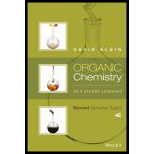
Concept explainers
Want to see the full answer?
Check out a sample textbook solution
Chapter 4 Solutions
Organic Chemistry As a Second Language: Second Semester Topics
Additional Science Textbook Solutions
Applications and Investigations in Earth Science (9th Edition)
Microbiology: An Introduction
Fundamentals Of Thermodynamics
Introductory Chemistry (6th Edition)
Human Anatomy & Physiology (2nd Edition)
College Physics: A Strategic Approach (3rd Edition)
- 1. If the following molecule underwent a radical bromination (just add one bromine) - draw the product and then draw an energy diagram to explain why you drew the product you showed. Br₂ light ?arrow_forwardPlease correct Answer and don't use Hand ratingarrow_forwardPlease don't use Ai solutionarrow_forward
 Organic ChemistryChemistryISBN:9781305580350Author:William H. Brown, Brent L. Iverson, Eric Anslyn, Christopher S. FootePublisher:Cengage Learning
Organic ChemistryChemistryISBN:9781305580350Author:William H. Brown, Brent L. Iverson, Eric Anslyn, Christopher S. FootePublisher:Cengage Learning

